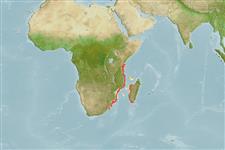Common names from other countries
Environment: milieu / climate zone / depth range / distribution range
Ecologie
; diepteverspreiding 180 - 750 m (Ref. 106911), usually 400 - 500 m (Ref. 106911). Tropical, preferred 26°C (Ref. 107945); 3°S - 33°S, 31°E - 46°E (Ref. 4)
Southwest Atlantic and Indo-West Pacific: from Kenya to Natal.
Length at first maturity / Size / Gewicht / Leeftijd
Maturity: Lm 4.9, range 3 - ? cm Max length : 20.5 cm TL mannelijk/geslacht niet bekend; (Ref. 122061); 20 cm TL (female)
It has a maximum total length of 20.5 cm (male) and 20 cm (female); and carapace lengths of 4.5 to 8.8 cm (male) and 3.7 to 8.3 (female). Minimum depth range from Ref. 122059. Occurs at depths from 200 to 750 m, but most common between 400 and 500 m (Ref. 4). Occurs along the edge of the continental slope on soft muddy substrata (Ref. 106911).
Life cycle and mating behavior
Geslachtsrijpheid | Voortplanting | Kuitschieten | Eieren | Fecundity | Larven
Ovigerous females between December and June (Ref. 4).
Holthuis, L.B. 1991. (Ref. 4)
Status op de Rode Lijst van het IUCN (Ref. 130435)
Status bij CITES (Ref. 108899)
Not Evaluated
Not Evaluated
Gebruik door de mens
Visserij: commercieel
FAO - Visserij: landings | FishSource | Sea Around Us
Tools
Meer informatie
Leeftijd/Grootte
Groei
Lengte-gewicht parameters
Lengte-lengte parameters
Morfologie
Larven
Abundantie
Internet-bronnen
Estimates based on models
Preferred temperature
(Ref.
115969): 10 - 12.3, mean 11.4 (based on 9 cells).
Weerstandsvermogen
Hoog, minimale populatieverdubbelingstijd minder dan 15 maanden (K=0.45-0.48).
Kwetsbaarheid
Low vulnerability (11 of 100).
